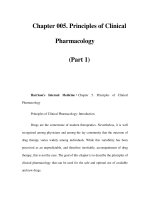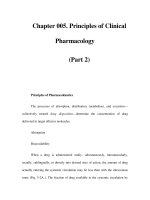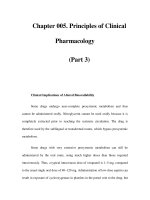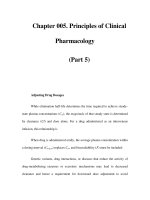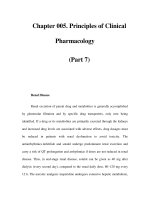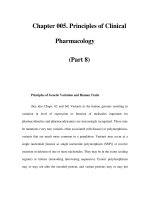Chapter 005. Principles of Clinical Pharmacology (Part 9) pps
Bạn đang xem bản rút gọn của tài liệu. Xem và tải ngay bản đầy đủ của tài liệu tại đây (15.16 KB, 5 trang )
Chapter 005. Principles of Clinical
Pharmacology
(Part 9)
Transferase Variants
One of the most extensively studied phase II polymorphisms is the PM trait
for thiopurine S-methyltransferase (TPMT). TPMT bioinactivates the antileukemic
drug 6-mercaptopurine. Further, 6-mercaptopurine is itself an active metabolite of
the immunosuppressive azathioprine. Homozygotes for alleles encoding the
inactive TPMT (1 in 300 individuals) predictably exhibit severe and potentially
fatal pancytopenia on standard doses of azathioprine or 6-mercaptopurine. On the
other hand, homozygotes for fully functional alleles may display less anti-
inflammatory or antileukemic effect with the drugs.
N-acetylation is catalyzed by hepatic N-acetyl transferase (NAT), which
represents the activity of two genes, NAT-1 and NAT-2. Both enzymes transfer an
acetyl group from acetyl coenzyme A to the drug; NAT-1 activity is generally
constant, while polymorphisms in NAT-2 result in individual differences in the rate
at which drugs are acetylated and thus define "rapid acetylators" and "slow
acetylators." Slow acetylators make up ~50% of European- and African-derived
populations but are less common among Asians.
Slow acetylators have an increased incidence of the drug-induced lupus
syndrome during procainamide and hydralazine therapy and of hepatitis with
isoniazid. Induction of CYPs (e.g., by rifampin) also increases the risk of
isoniazid-related hepatitis, likely reflecting generation of reactive metabolites of
acetylhydrazine, itself an isoniazid metabolite.
Individuals homozygous for a common promoter polymorphism that
reduces transcription of uridine diphosphate glucuronosyltransferase (UGT1A1)
have benign hyperbilirubinemia (Gilbert's syndrome; Chap. 297). This variant has
also been associated with diarrhea and increased bone marrow depression with the
antineoplastic prodrug irinotecan, whose active metabolite is normally detoxified
by this UGT1A1-mediated glucuronidation.
Variability in the Molecular Targets with Which Drugs Interact
As molecular approaches identify specific gene products as targets of drug
action, polymorphisms that alter the expression or function of these drug targets—
and thus modulate their actions in patients—are also being recognized. Multiple
polymorphisms identified in the
2
-adrenergic receptor appear to be linked to
specific phenotypes in asthma and congestive heart failure, diseases in which
2
-
receptor function might be expected to determine prognosis. Polymorphisms in the
2
-receptor gene have also been associated with response to inhaled
2
-receptor
agonists, while those in the
1
-adrenergic receptor gene have been associated with
variability in heart rate slowing and blood pressure lowering (Fig. 5-5B ). In
addition, in heart failure, a common polymorphism in the
1
-adrenergic receptor
gene has been implicated in variable clinical outcome during therapy with the beta
blocker bucindolol. Response to the 5-lipoxygenase inhibitor zileuton in asthma
has been linked to polymorphisms that determine the expression level of the 5-
lipoxygenase gene. Herceptin, which potentiates anthracycline-related
cardiotoxicity, is ineffective in breast cancers that do not express the herceptin
receptor; thus, "genotyping" the tumor is a mechanism to avoid potentially toxic
therapy in patients who would derive no benefit.
Drugs may also interact with genetic pathways of disease, to elicit or
exacerbate symptoms of the underlying conditions. In the porphyrias, CYP
inducers are thought to increase the activity of enzymes proximal to the deficient
enzyme, exacerbating or triggering attacks (Chap. 352). Deficiency of glucose-6-
phosphate dehydrogenase (G6PD), most often in individuals of African or
Mediterranean descent, increases risk of hemolytic anemia in response to
primaquine and a number of other drugs that do not cause hemolysis in patients
with normal amounts of the enzyme (Chap. 101). Patients with mutations in the
ryanodine receptor, which controls intracellular calcium in skeletal muscle and
other tissues, may be asymptomatic until exposed to certain general anesthetics,
which trigger the syndrome of malignant hyperthermia. Certain antiarrhythmics
and other drugs can produce marked QT prolongation and torsades des pointes
(Chap. 226), and in some patients this adverse effect represents unmasking of
previously subclinical congenital long QT syndrome.
Polymorphisms that Modulate the Biologic Context Within Which the
Drug-Target Interactions Occur
The interaction of a drug with its molecular target is translated into a
clinical action in a complex biologic milieu that is itself often perturbed by
disease. Thus, polymorphisms that determine variability in this biology may
profoundly influence drug response, although the genes involved are not
themselves directly targets of drug action. Polymorphisms in genes important for
lipid homeostasis (such as the ABCA1 transporter and the cholesterol ester
transport protein) modulate response to 3-hydroxymethylglutaryl-CoA (HMG-
CoA) reductase inhibitors, "statins." In one large study, the combination of
diuretic use combined with a variant in the adducin gene (encoding a cytoskeletal
protein important for renal tubular sodium absorption) decreased stroke or
myocardial infarction risk, while neither factor alone had an effect. Common
polymorphisms in ion channel genes that are not themselves the target of QT-
prolonging drugs may nevertheless influence the extent to which those drugs
affect the electrocardiogram and produce arrhythmias. These findings not only
point to new mechanisms for understanding drug action, but also can be used for
drug development. For example, a set of polymorphisms in the gene encoding 5-
lipoxygenase activating protein (FLAP) has been identified as a risk factor for
myocardial infarction in an Icelandic population, and an initial clinical trial of a
FLAP inhibitor was conducted only in subjects with the high risk allele.


